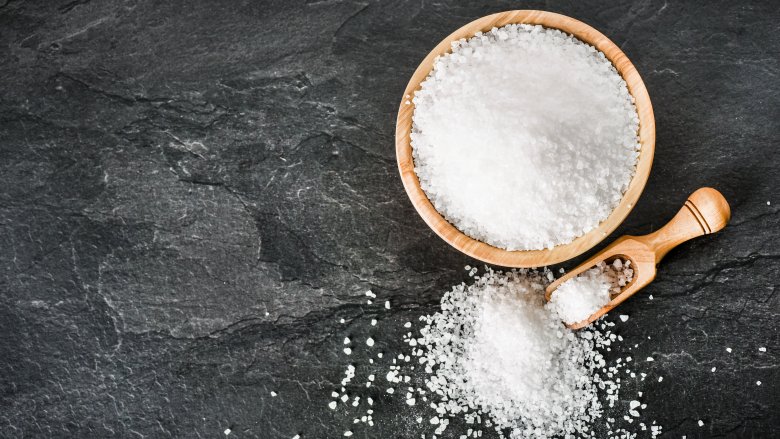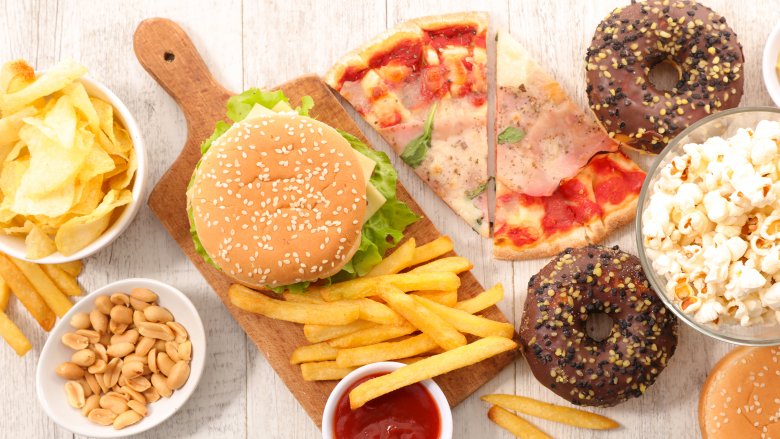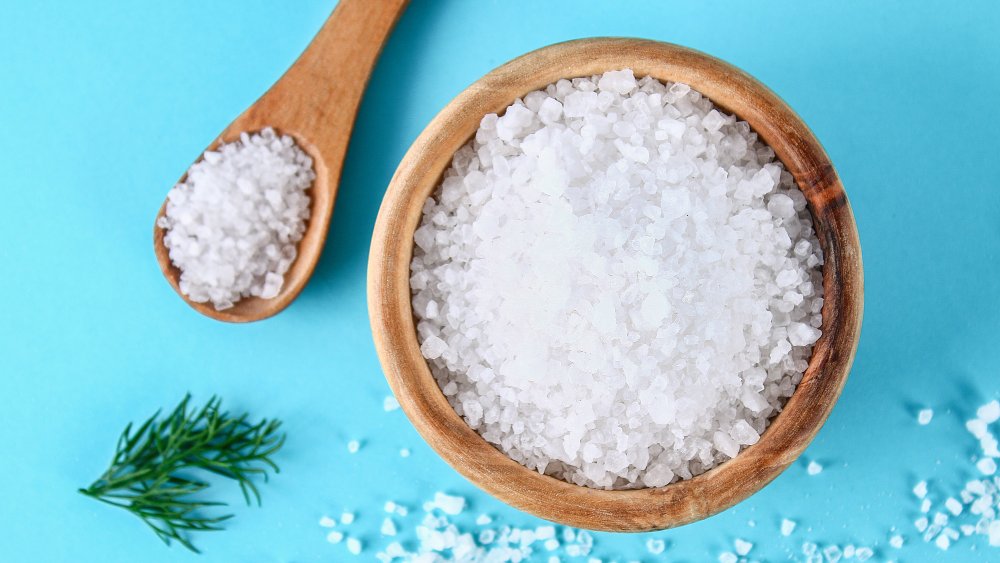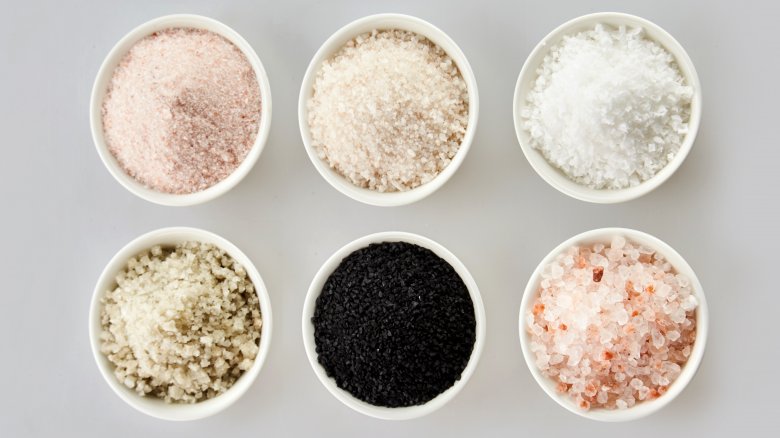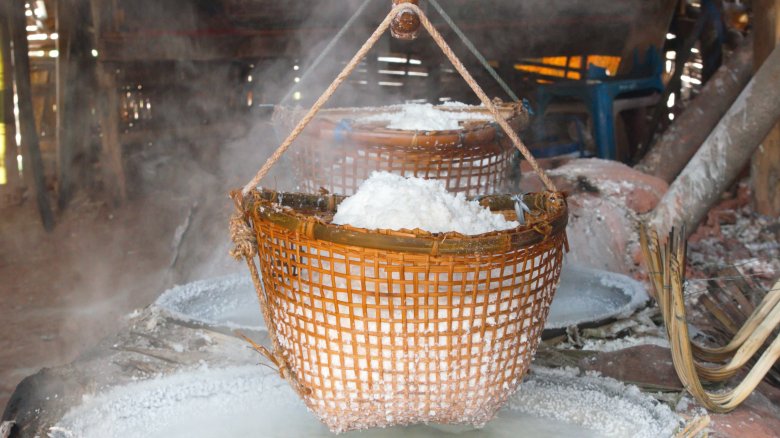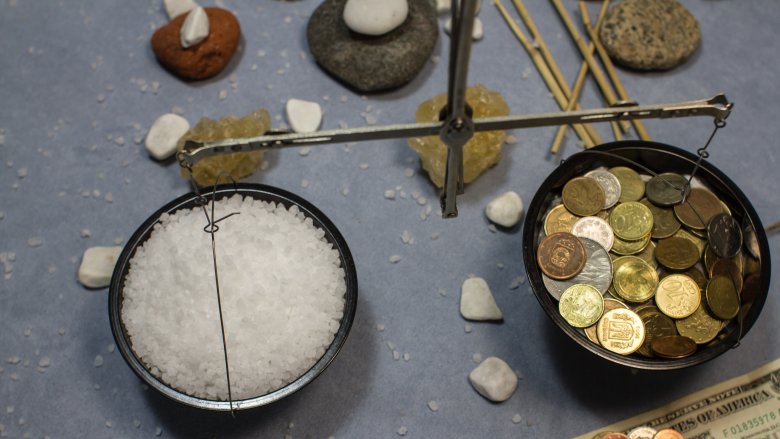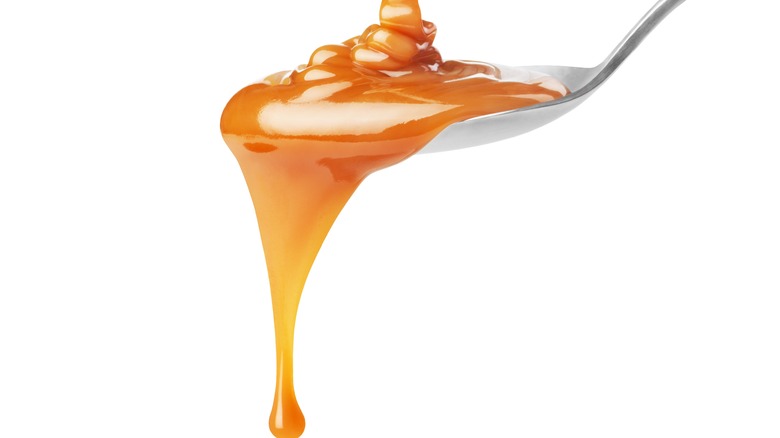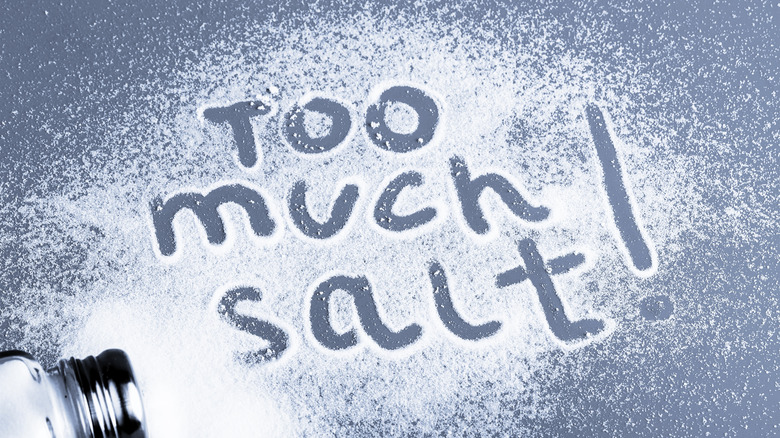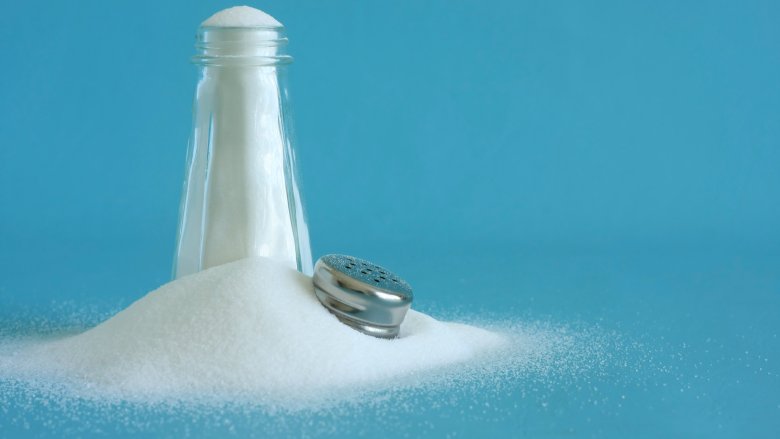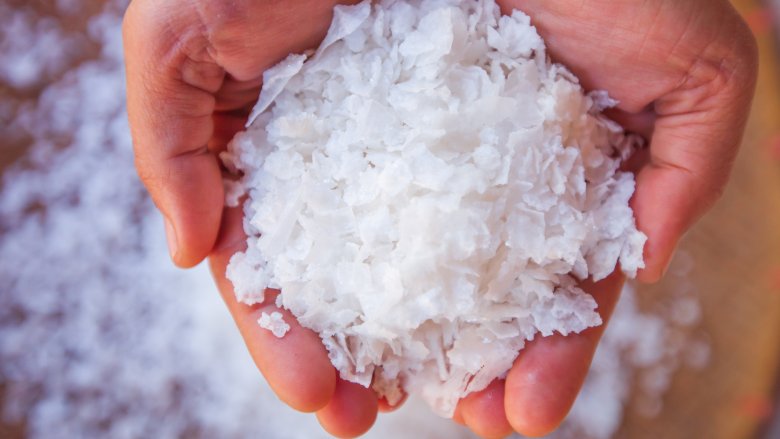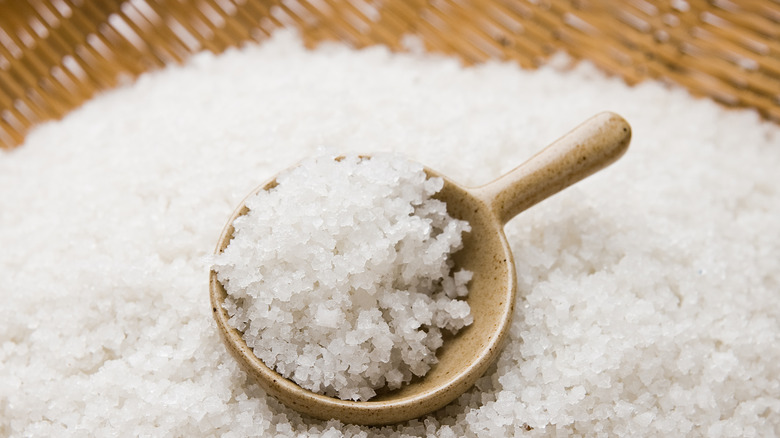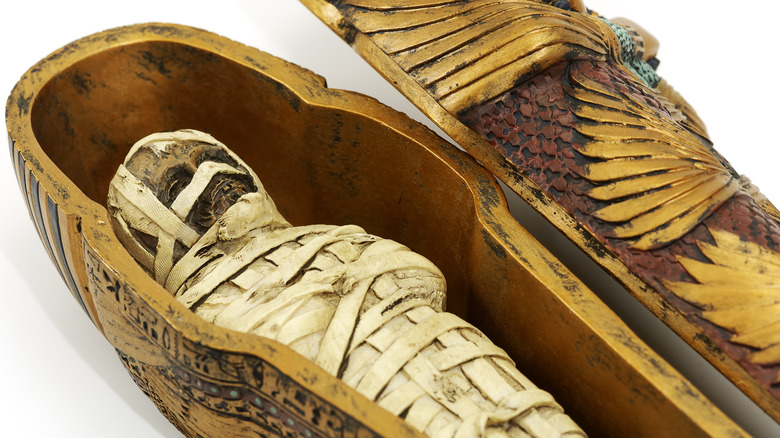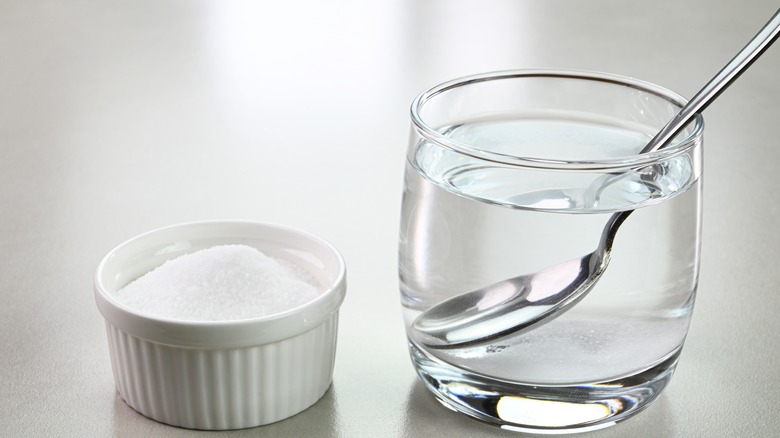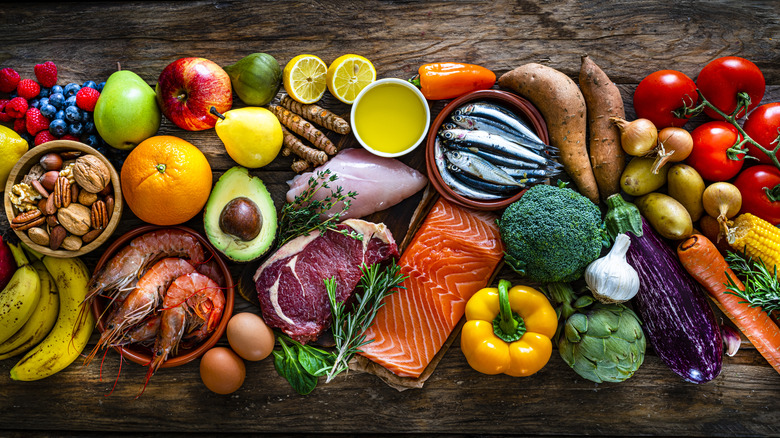16 Little-Known Facts About Salt
Salt is everywhere. Even if you can't taste it, chances are good it's in everything from your breakfast oatmeal to the salad you brought for lunch. According to the FDA, Americans eat on average 3,400 milligrams of sodium, a chemical element found in salt, each day (over 1,000 milligrams more than the daily recommended value, the equivalent of one teaspoon). Salt consumption has gotten out of control, turning from a way to preserve food into a cheap commodity used to flavor our favorite salty snacks. It's so inexpensive that you probably don't think twice about the price tag of a box at the store (unless you're opting for a bottle of the expensive pink Himalayan salt).
It wasn't always that way, though. Salt has been around for thousands of years, and it was once so valuable that people traded it ounce-per-ounce with gold. Wars were fought over it, and it inspired a lively black market throughout Europe and Asia. There's even a way that salt might bring you good luck. So how did such a valuable product become the mass-produced product that we haphazardly add to food, one pinch at a time? You might be surprised to find out some of these lesser-known facts about everyone's favorite seasoning, salt.
You're probably eating too much salt
Your body might need salt to function, but it doesn't need that much. Our bodies only need 186 milligrams each day — that's less than what fits in a tenth of a teaspoon. Unfortunately, consuming such a small amount of sodium is close to impossible since salt is in almost everything we eat and drink. Various health organizations suggest a daily maximum of 1.5 to 2.3 grams to prevent health concerns like high blood pressure, but we eat way more than that. The Harvard School of Public Health estimates most Americans consume 3.4 grams (or 1.5 teaspoons) of sodium per day. If you're in that group, that means you're eating 18 times more salt than your body needs to function!
It's not so easy to cut back on salt intake, either. The American Heart Association warns consumers that the sodium in our diet isn't coming from the salt shaker. As much as 70% comes from packaged or restaurant food, which makes it hard to know the actual amount of salt you put into your body. The best way to cut back is to skip the pre-made, boxed, or bagged food and try to prepare your meals from fresh meats, grains, and produce.
Salt might just raise the world's IQ
It's a wild claim, to think that something as common as salt might be able to make the world a smarter place, but it's entirely possible. The reason is iodine. Around a third of the world's population teeters on the brink of an iodine deficiency. What does that mean? Not only does iodine keep our thyroid functioning properly, but it's also crucial for healthy and normal brain function.
Here's where intelligence comes in. Among those at the highest risk for iodine deficiency are pregnant people. Studies suggest that iodine-deficient people who give birth will likely have a child with an IQ between 10 and 15 points lower than they would have had if sufficient levels of iodine were included in that pregnant person's diet.
Given that one of the most common sources of iodine is iodized salt, it's a deficiency that's easily preventable — with a little salt and a lot of education. In 1990, the World Summit for Children pushed for a campaign championing the benefits of iodized salt, and it got real results. Take Kazakhstan, for example. In the 1990s, they were one of the most iodine-deficient countries in the world, with as many as 10% of their children suffering from stunted growth and developmental difficulties. By 2006, they had increased the usage of iodized salt and were looking forward to a United Nations declaration that they were free of iodine deficiency disorders.
There are different kinds of salt, but one isn't healthier than another
There are all kinds of different salts. The mineral mixes can vary depending on where salt is harvested, and there are various methods of processing salt. The variety of sea salts is almost endless because you can produce salt from anywhere there is saltwater. Water from 2,200 feet off the Hawaiian coastline creates Kona deep water sea salt, and salt mined in the Punjab region of Pakistan turns pink from trace amounts of iron oxide, creating Himalayan sea salt.
Although each type of salt has a different flavor (especially those blended with seasonings like truffles), they all have a similar sodium content. Unfortunately, most people don't know that one type of salt isn't healthier than another. In a 2011 American Heart Association survey, 61% of the 1,000 people surveyed thought that sea salt is a low-sodium alternative to table salt. Kosher salt and some sea salts do indeed contain less sodium by volume because their flakes are larger in size than table salt. But, table salt and most sea salts contain the same amount of sodium by weight: 40%. So go ahead and use sea salt if you like the flavor, but it won't actually be any healthier than regular salt.
There are different ways we get salt
If you've ever seen the words "rock salt" and "sea salt" on packages, it's because they're technically two different products. Sea salt is made from evaporated salt water. The oldest way to produce salt involves capturing seawater in shallow ponds. The sun evaporates most of the water to create a concentrated brine. Eventually, all the water evaporates, leaving crystallized salt behind. Today, some salt producers force the process by using commercial equipment called vacuum pans. The concentrated saltwater brine is boiled under pressure, creating a high-quality, finely textured salt.
Rock salt, on the other hand, doesn't involve any water at all. Salt also grows thousands of feet below the earth in underground mines. Miners access the salt via mineshafts, drill holes, and blast the rock salt out of the walls using explosives. From there, the salt is crushed and sorted. Is there a difference between the two products? A little: Sea salt contains more trace minerals, and rock salt is sometimes gray due to impurities in the rock. Some people say that rock salt has a more concentrated flavor, too.
Salt was once used as currency
Have you ever heard the saying that someone is "not worth one's salt?" That's because salt was once so valuable, it was used as currency. Before refrigeration, salt was the only way to preserve food, and anyone without it couldn't travel to new lands without their food spoiling. In ancient Rome, soldiers were often paid in salt (or, given an allowance with which to purchase salt). The word "salary" even comes from the Latin word for salt, sal. So, if a soldier was doing a lousy job, his paycheck would be cut because he wouldn't be worth his salt.
Salt as a currency isn't restricted to ancient times, either. According to a 1962 article in the Journal de la Société des Africanistes, Ethiopians used goods in place of money for a millennium and a half. The main form of currency was salt, and it was said that "whoever carries it finds all that he requires." Using axes, the salt was cut into large blocks called amole and carried by a donkey caravan across the country. If a block broke in transit, it lost value. This practice continued into the 20th century in some remote areas. Even today, Maldon Salt Company suggests taking a pack of salt into the country if you visit, in case of emergencies.
Leonardo da Vinci might be responsible for superstition that spilling salt is bad luck
If you're superstitious, you may think it's bad luck to spill salt. If you do, legend dictates that you're supposed to pick up a pinch and toss it over your left shoulder to prevent bad luck from following you around. Where did this fear come from? Some believe that it came from ancient times when salt was very expensive. Anyone who wasted such a precious commodity was branded as bad luck to motivate people to be more careful with their salt use.
That may be the answer, but it could also be Leonardo da Vinci's fault. In his "The Last Supper" painting, you'll see a container of spilled salt at Judas Iscariot's elbow. Because it's so close to his arm, one can assume that Judas accidentally knocked the vessel over at some point during the dinner. The Bible describes how Judas went on to betray Jesus after this dinner, so salt spilling became associated with dishonesty, treachery, and bad fortune.
An inventor made millions by selling a salt gun
Although it's no longer used as currency or to pay our salaries, salt is still big business today. Table salt might be cheap, but pink Himalayan salts are up to 20 times more expensive (and that bright pink color is oh-so-Instagramable). It's not just for eating, either; Himalayan salt glow lamps have been trending on Amazon for a long time, and there's a hotel in Bolivia that is built with salt. It reportedly took one million 14-inch blocks of compressed salt to make it happen!
One of the most impressive salt-related product is the Bug-A-Salt gun. Lorenzo Maggiore always had the idea to make a gun to kill flies. CNBC reports that when he did, he became a millionaire. The gun uses ordinary table salt as its "ammo," spraying granules of salt at a fly to safely remove it from your dining room table. The Indiegogo campaign for the product received over $500,000 in funding, and in 2018 the company reached revenues of $27 million. It's a pretty impressive use for regular old table salt!
Salt helps balance flavors
Five elements create our experiences of flavor: bitterness, sweetness, umami, and sourness. Saltiness is the fifth and employs two distinct mechanisms to pack a particular dish with flavor. First, it neutralizes bitterness, and second, brings the positive attributes of other flavors to the fore. This means that where sweetness is the star of the culinary show, salt holds the spotlight in just the right angles to allow it to shine.
This common practice of using salt to enhance the flavors of other foods dates as far back as 10,000 years. This is made especially potent by the fact that salt has a wide spectrum of "bliss points" at which its addition makes a food pleasant tasting. Moreover, not only does it balance flavors and make it more pleasant tasting, it can contribute to other aspects of the taste experience, like making a soup thicker — which in turn, gives the sensation of more comfort -– particularly on a cold day.
Symptoms of consuming too much salt
It's relatively easy to consume the recommended daily sodium intake because you can find it through most of the foods you eat on a regular day. This means that it can also be fairly easy to consume too much salt –- whether this is during a meal, or over a single day. There are both short-term and long-term drawbacks of too much salt in one's diet. Among the short-term effects are increased bloatedness, swollen hands and feet as a result of water retention, intense thirst, and in extreme cases, hypernatremia.
Hypernatremia occurs when water shifts from your cells to your blood to compensate for heightened sodium levels. It can be fatal if untreated. In cases where too much salt is consumed over an extended period, an individual may increase their risk of developing stomach cancer, as high sodium consumption may hurt the stomach lining by way of ulcers and inflammation. Finally, too much salt can also result in high blood pressure –- albeit temporarily, particularly if your body is more sensitive to salt — regardless of whether it was consumed in a single meal or over time. Ultimately, it's exceptionally rare to overdose on salt, but it remains vital to know the impact of tipping the scales in that direction, especially if your diet is rich in processed foods.
New York City led the charge for restricting salt use
New York City has had some pretty edgy restaurant bans over the years. They prohibited restaurants from using trans fats in 2006, and they were the first city in the nation to require chain restaurants to post calorie counts on their menu boards. So, no one should have been surprised whenm in 2010, then-mayor Michael Bloomberg rolled out the National Salt Reduction Initiative (NSRI). This voluntary plan called for companies to reduce the sodium content in their food by 25% over five years, gradually pulling salt away so "the change is not so noticeable to consumers."
In 2016, the New York City Health Department reported the program was successful in reducing sodium levels by about 7% in a sample of top-selling packaged foods. The success led to a new campaign aimed to educate the public with a sodium warning icon. These warnings would appear on restaurant chain menus when a menu item has sodium content higher than 2,300 milligrams, the total daily recommended limit. Sounds good to us; who wants to eat an entire day's worth of salt in one sitting?
Salting the corners of your house might bring you good luck, peace, and prosperity
Throughout history, salt played a role in many religions to purify objects or repel evil. In Buddhist tradition, salt is used to repel evil spirits, and they're known to throw salt over their shoulders after funerals to make sure evil spirits don't follow them home. The Shinto religion also used salt to purify an area, which is why salt is thrown into the center of the ring before sumo wrestling matches: to remove malevolent spirits.
Want to use salt to purify your own home? Pouring salt in the corners of your house will reportedly bring you good luck, peace, and prosperity. An easy salt ritual involves standing in the middle of your room, picking up handfuls of salt, and spraying it in the corners of the room while moving in a clockwise direction. This drives away negative energy, purifying and protecting your home. It's worth a try right?
The world's most expensive salt comes from South Korea
You've probably never thought of paying over $100 for a cup of salt. However, that's exactly what you'd be looking at with Korean bamboo salt. Sometimes called purple bamboo salt, Korean bamboo salt has seen some of its makers earn up to $24 million in a single year. Not only is it used for cooking, but it's also hailed as a traditional medicine that contains more calcium, iron, and potassium than regular salt, and boasts benefits like aiding digestion, soothing inflammation, and supporting skin and oral health.
While more scientific research is needed to support these health benefits, the real reason bamboo salt is so expensive has much to do with the process of making it. It's reportedly a labor-intensive process that entails sea salt being roasted in bamboo shoots at temperatures of higher than 1,400 degrees Fahrenheit. This is usually repeated nine times over 30 days. All of this is done by hand, and it's believed that the process allows minerals to be infused into the salt while simultaneously stripping it of any toxins that may be present. With all salt does to enhance flavor, bamboo salt is said to also absorb a bamboo-like flavor -– which must do wonders for the flavor profile of whatever dish it's added to.
It can preserve people as well as food
Salt makes a great preservative for food because of its ability to stop or slow water movement so microbial growth and chemical reactions happen more slowly. This means that salted food doesn't decay as quickly. Just as salt can help slow down microbial attacks on food to preserve them, salt can help preserve human bodies.
The ancient Egyptians were likely one of the first people to discover that they could preserve both food and human bodies with salt. Records show that ancient Egypt even had a dedicated tax category for salted meats that merchants floated down the Nile. This tax applied whether it was a salted side of beef or a salt-laden human mummy in the cargo.
Salt can even naturally mummify people, as happened to the Iranian mummies found in a salt mine in 1993. Somewhere between B.C. 500 to A.D. 500, the remains of these people were mummified by salt found in and around their burials. Even today, some prisons in places such as Syria use salt preservation instead of traditional morgues. And a 2022 case study published in the International Journal of Legal Medicine described how a son kept his dead mother preserved in table salt so he could continue to collect her pension. While a few insects and fungi colonized her mummified body, it was still in otherwise good condition when officials discovered it two years later.
Salt is a natural enemy of infection and disease
Given that salt can arrest bacterial growth and preserve food, it makes sense that it is also helpful in keeping infection and disease at bay. A study presented at the 2023 American College of Allergy, Asthma, and Immunology conference showed significantly lower hospitalization rates for people with COVID-19 who gargled and rinsed their nasal passages with salt water for two weeks. Furthermore, a study in Scientific Reports found that a salt coating helped reduce flu virus replication on cloth face masks.
A 2021 Gaceta Sanitaria study showed that a 7% solution of table salt in water healed wounds in mice faster than the control group. Curiously, a study in Cell Metabolism indicates that our skin collects salt from our body to help white blood cells that were working near the site of infections. Researchers also successfully cleared up skin infections in mice with a high-salt diet.
However, it's important to know that consuming salt in your diet has the opposite effect in some situations. A study published in EMBO revealed that mice fed a high-salt diet had lowered immune function. Another EMBO study shows that high salt intake reduces the body's ability to fight off viruses. A low-salt diet may be more valuable during outbreaks of viral disease. We also know that high-sodium diets can exacerbate high blood pressure and may inhibit the function of key organs like your kidneys and brain.
It has played a role in spirituality and religion
Salt has had spiritual and religious significance throughout history. The Aztec goddess Huixtocihuatl reigned over salt, salt water, and those who worked in the salt industry. The Hopi people of the American Southwest had special rituals for those traveling the Hopi Salt Trail to acquire salt, and the Zuni still make ceremonial pilgrimages to the Old Salt Mother at the Zuni Salt Lake in New Mexico. Meanwhile, the Aboriginal people tell tales about how salt got to inland Australia with warnings of monsters stalking salt lakes.
Salt was part of Jewish temple sacrifices, with Leviticus 2:13 specifying that offerings must include salt. Some Jews still dip their bread in salt in observance of this command. The Catholic Church has also sometimes used salt to bless altars, once employed it to baptize babies, and is reportedly used in exorcisms.
People have protected themselves from evil spirits and the evil eye by carrying salt in amulets, jars, or small packets. Others have sprinkled salt outside their doors to protect themselves from witches or evil spirits. European-based superstition often holds that you should throw salt over your left shoulder to get rid of bad spirits. Additionally, Shintos purify sumo wrestler rings by throwing salt into the ring before a match (which may be as much against germs as being spiritual).
It's possible to get all your sodium from whole foods
While the human body needs sodium to survive, it doesn't have to come through salt. Back when humans lived as hunters and gatherers instead of villages, we got all the sodium we needed from meat and other foods.
According to Baylor University Medical Center Proceedings, Paleolithic humans who lived 2.5 million to 12,000 years ago were likely consuming less than a gram of salt each day in a genuine Paleo diet. Humans didn't begin to use salt as much until 5,000 to 10,000 years ago when agriculture arose and many used salt to preserve food.
Today, indigenous Yanomami people living in the Amazon rainforest still eat a seminomadic diet comprised of food they grow, gather, and hunt. According to Johns Hopkins Magazine, Yanomami eat less than 100 milligrams of sodium each day, while the International Journal of Epidemiology more cautiously puts Yanomami sodium intake at less than 0.5 grams (500 milligrams) per day. Most estimates maintain that you need about 500 milligrams of sodium for your body to function properly. Considering that you can eat a medium-sized carrot and get 42 milligrams of sodium or eat an unsalted egg for 80 grams of sodium, salt just isn't necessary.
